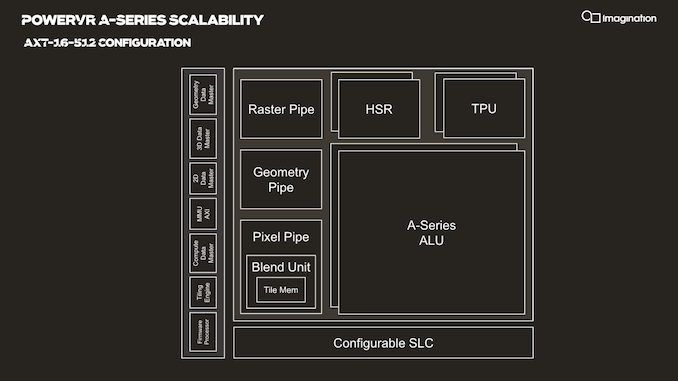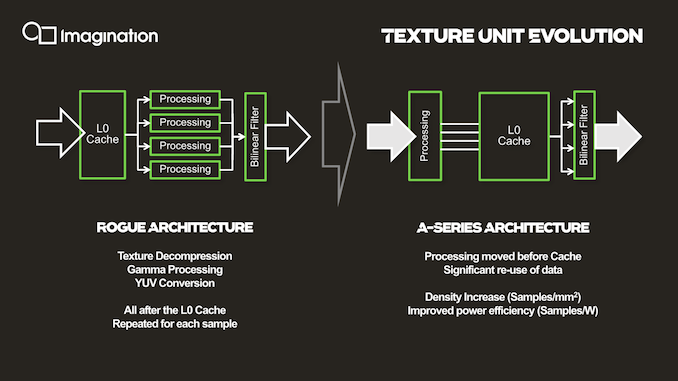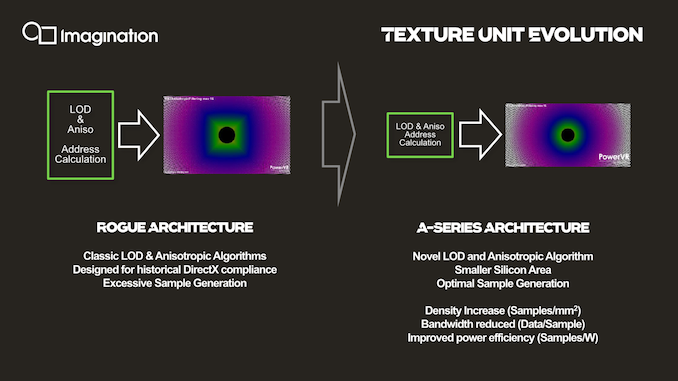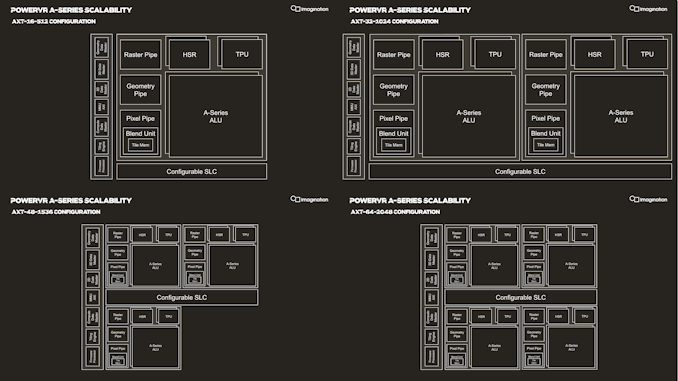Imagination Announces A-Series GPU Architecture: "Most Important Launch in 15 Years"
by Andrei Frumusanu on December 2, 2019 8:00 PM ESTFixed Function Changes & Scalability
Zooming out from the ALU, we’re seeing a higher-level block configuration that’s very similar to past Imagination PowerVR GPUs. The ALUs themselves are still housed in the larger cluster block that’s called the USC, or unified shading cluster. The USC along with various other fixed function blocks is in turn housed in an SPU, or shader processing unit, effectively the scaling block regularly referred to as a “core”.
Each SPU houses two USCs in the current IP configuration, meaning we have two clusters of 128-wide ALUs. This is valid for all AXT parts, but we imagine the AXM-8-256 unit just has a single USC. The AXT-16-512 is the smallest configuration with a fully populated SPU.
Each SPU has its own geometry pipeline, and up to two texture processing units. The A-Series carries over the per-TPU throughput design from the Furian architecture, meaning the block is able to sample 8 bilinear filtered texels per clock. The A-Series doubles this up now per SPU and the AXT models feature two TPUs, bringing up the total texture fillrate to 16 samples per clock per SPU.
The microarchitecture of the texture units has also evolved beyond just their throughput. A bigger improvement that Imagination is disclosing is the handling and location of the L0 cache. The L0 cache has been relocated within the texturing workflow to between the processing and filtering stages, allowing the L0 cache to hold the outputs of the processing stage, rather than the inputs. This allows for what Imagination calls significant data reuse, as texels don't need to be re-processed each time they're needed. And given how many times a texel may need to be sampled during anisotropic filtering, it's easy to see why. With the benefit of hindsight, this seems like an obvious improvement to make, but the company says that the design choices of the legacy configuration made sense at the time of conception and the workloads back then.
Imagination also talks about how the anisotropic filtering quality of the new architecture is much improved. In a set of comparison screenshots using a traditional texture tunnel, Imagination is showcasing that its new anisotropic filtering algorithms are far closer to being angle-independent – the ideal outcome for aniso filtering – as opposed to angle-dependent filtering with rather hard 90 degree angles on Rogue. Interestingly, Imagination is claiming that they've achieved this improved angle-independence even with fewer fewer samples, all of which serves to improve their efficiency and hardware density. With all of that said, since the comparison is against the Rogue architecture, I’m not entirely sure if it’s an actual novelty of the A-Series or rather a rehash of the anisotropic improvements that already got introduced in the 9XM series last year.
Another change in the fixed function units is found in the pixel pipeline, although superficially the throughput here doesn’t change compared to what we’ve seen on Furian. There’s still up to two PBEs with throughputs of up to 4 pixels per clock, and the design houses two such units for a total of 8 pixels per clock per SPU. There’s actually more internal distinction of the units though – at the front and back core it’s still able to handle 16 pixels per clock and also blend at 16 pixels per clock, although it’s limited on write out to 8 PPC on 1:1 pixel:texture situations.
Imagination’s doubling of the texture throughput whilst maintaining a steady pixel throughput means that the company is generally matching the decreasing pixel:texel fillrate throughput ratio we’ve also seen in other architectures such as from Qualcomm as well as the new Mali-G77, and now falls in at a 1:2 pixel:texel for the A-series.
Alpha blending is now done on a dedicated hardware unit in the pixel pipeline instead of being computed by the ALUs. The change results in higher performance through the use of fixed function hardware, allowing for things such as FP16 blending at full rate, and frees up the ALUs themselves so that they can use their computation resources on other work. Density is improved, but more importantly it’s also improving power efficiency as it’s avoiding using more expensive and less task-specific hardware for the same tasks.
It’s to be noted that for the AXM series, the company uses customized fixed function units that are more area efficient, rather than just only scaling the numbers of units.
Scaling Things Up
With the SPU being the coarsest scaling block of the architecture, Imagination is building larger GPU configurations by simply adding in more SPUs. Essentially this is the “core” scaling of Imagination's GPU designs.
Scaling of SPUs across the AXT line happens in multiples of 16-512 across the range, both in terms of their product names as well as their texture and FLOPs/clock capabilities, which is rather simple to grasp and very quickly understand a configuration’s capabilities. As mentioned in the introduction, Imagination views the AXT-32-1024 as being the most popular choice for vendors targeting the high-end premium smartphone SoC segment, which possibly some vendors opting to go with the AXT-48-1536 for a larger area and lower clock speeds for more efficiency. The AXT-64-2048 would be a really big GPU which the company could build if there’s costumer interest.
| PowerVR GPU Comparison | ||||
| AXT-16-512 | GT9524 | GT8525 | GT7200 Plus | |
| Core Configuration |
1 SPU (Shader Processing Unit) - "GPU Core" 2 USCs (Unified Shading Clusters) - ALU Clusters |
|||
| FP32 FLOPS/Clock MADD = 2 FLOPs MUL = 1 FLOP |
512 (2x (128x MADD)) |
240 (2x (40x MADD+MUL)) |
192 (2x (32x MADD+MUL)) |
128 (2x (16x MADD+MADD)) |
| FP16 Ratio | 2:1 (Vec2) | |||
| Pixels / Clock | 8 | 4 | ||
| Texels / Clock | 16 | 8 | 4 | |
| Architecture | A-Series (Albiorix) |
Series-9XTP (Furian) |
Series-8XT (Furian) |
Series-7XT (Rogue) |
Comparing the smallest AXT-16-512 configuration with a single SPU and two USCs against similar configurations across the generations, we indeed see that the new A-Series does bring large architectural changes.
Imagination is marketing a 4x increase in ALU throughput, but again that’s against the 9XM GPUs, which are equal in ALU configuration to the Series-7XT in the table. However, it’s not to say that the increases aren’t any less impressive when comparing to the previous 9XTP family; a rise from 240 FLOPs/clock to 512 is still a 2.13x increase.
I think what’s actually more important to note here is the architecture has very big building blocks. At 512 FLOPs and 8 pixels per clock, an AXT SPU is significantly bigger than an Arm Mali-G77 core which comes in at “only” 64 FLOPs/clock and 2 pixels per clock, meaning an AXT core is roughly equivalent to eight G77 cores in computational power and four G77s in fillrate throughput, which is a massive difference in terms of design scaling. Naturally, in terms of effective density and power efficiency, few big cores will always win over a flock of small cores, as demonstrated by Qualcomm and Apple’s recent 2- and 4-core designs.















143 Comments
View All Comments
RaduR - Tuesday, December 3, 2019 - link
Andrei Frumusanu was working for them . So maybe he has more info on how this is going to develop .The only downside for ImgTec is that they are depending on CPU vendors. So if they cannot sell this design to anyone ....
They tried with MIPS but for whatever reason MIPS lost traction . Most probably they wer eunable to sell the design .
Please understand that ImgTec is a very very small company that is fighting in fact with ARM . They are not Mediatek nor Qualcomm . In this market there is a lot of completion.
We have : Vivante in the lowend. Broad iMM has Videocore , ARM sells MALI together with Cortex designs. So how can ImgTec survive ?
I see the only option would have been MIPS + PowerVR or to be taken over by a company like Mediatek . I am still wondering why Intel did not buy them for the cheap or Mediatek .
Andrei Frumusanu - Tuesday, December 3, 2019 - link
I left back in November 2017 and avoided coverage till now due to any conflict of interest. The A-Series is beyond the horizon of future knowledge I had from back then so it was new to me, I don't have any more info beyond my estimates that I wrote.Vivante is effectively dead and so is the Videocore lineup, the best case scenario here is a 50/50 split with Arm. The CPU I thing I don't think it's a limitation as long as the GPU in fact does deliver on competitive PPA.
ZolaIII - Tuesday, December 3, 2019 - link
I wouldn't exactly say Unisoc adoption of it would have a small impact (tho they are still recovering from bad Intel's influence) nor would I write of possibility of HiSilicone adoption (more so as they are keen on ARM for US ban compliance & after all Chinese IPO owns Imagination now). Actually this is going so far right now that RISC V foundation is moving out of US to neutral grounds to ensure that same fate that struck the ARM cannot happen to them.vladx - Wednesday, December 4, 2019 - link
ARM is also planning to move remaining R&D centers from US to avoid any chance of US ban in the future.vladx - Wednesday, December 4, 2019 - link
Did anyone use Vivante designs in their SoCs in the past 3 years or so?GruenSein - Tuesday, December 3, 2019 - link
Uncertainties about ImgTech's claims and promises aside, I am wondering who is supposed to be the customer.Apple is developing their own GPUs now.
Samsung is going with AMD's RDNA.
Qualcomm has their Adreno GPU.
HiSilicon is using ARM's Mali.
I fear that this will be a very niche product unless it absolutely dominates all other solutions.
Raqia - Tuesday, December 3, 2019 - link
If they remain independent, I think it'll be anyone who wants something better than Mali or Intel that don't have their own GPU or haven't partnered up, so with Intel also designing their own GPU cores I guess the main customer would be Mediatek, and a handful of other even smaller licensees like Broadcom for things like its Raspberry Pi SoC, NXP, STM etc.When compared to CPU designs which are becoming increasingly commoditized by ARM's freely licensed and very good SIP cores (with only nVidia and Apple doing their own custom cores in volume going forward), efficient GPU cores continue to be highly specialized and a well sought after technology. Imagination would also be a layup acquisition for any company besides Apple, AMD, or Qualcomm, so I could Intel, Samsung or ARM buying them in the future.
Raqia - Tuesday, December 3, 2019 - link
Also Marvell and other TV / automakers.name99 - Tuesday, December 3, 2019 - link
Amazon made a big deal about GPU support and AI inference in their Graviton 2 announcement. They might be an unexpected client?(For that to work, however, IMG might have to be more flexible in terms of being willing to scale up/drop functionality to match AMZ's needs. They were apparently unwilling to be that flexible for Apple... But hey, near death experience can sometimes teach...)
mode_13h - Wednesday, December 4, 2019 - link
I'm sure Amazon is just talking about Nvidia and possibly AMD. Nvidia is officially supporting their software stack on ARM, and AMD's is opensource and could be recompiled for ARM (hey, it works on POWER!).